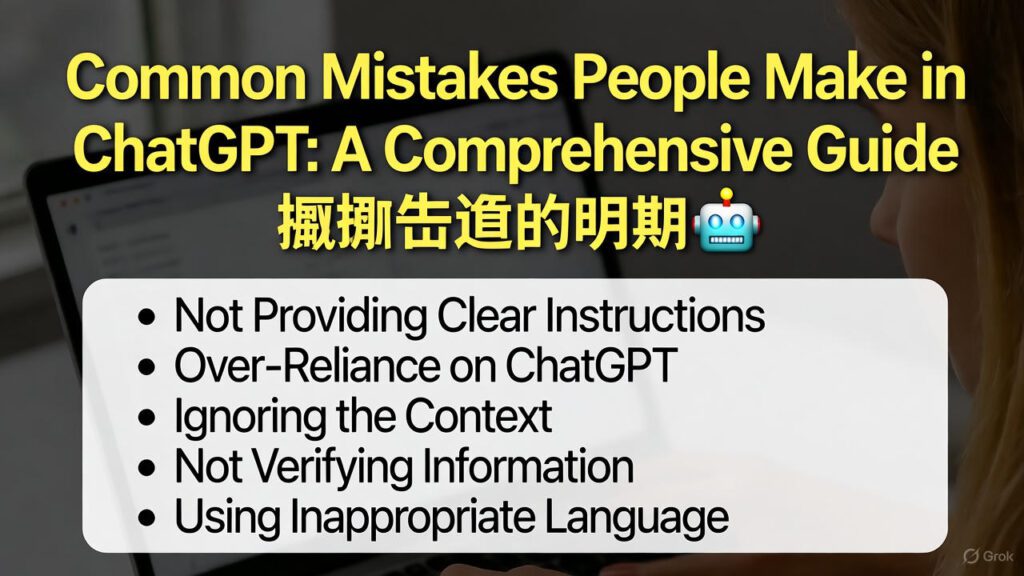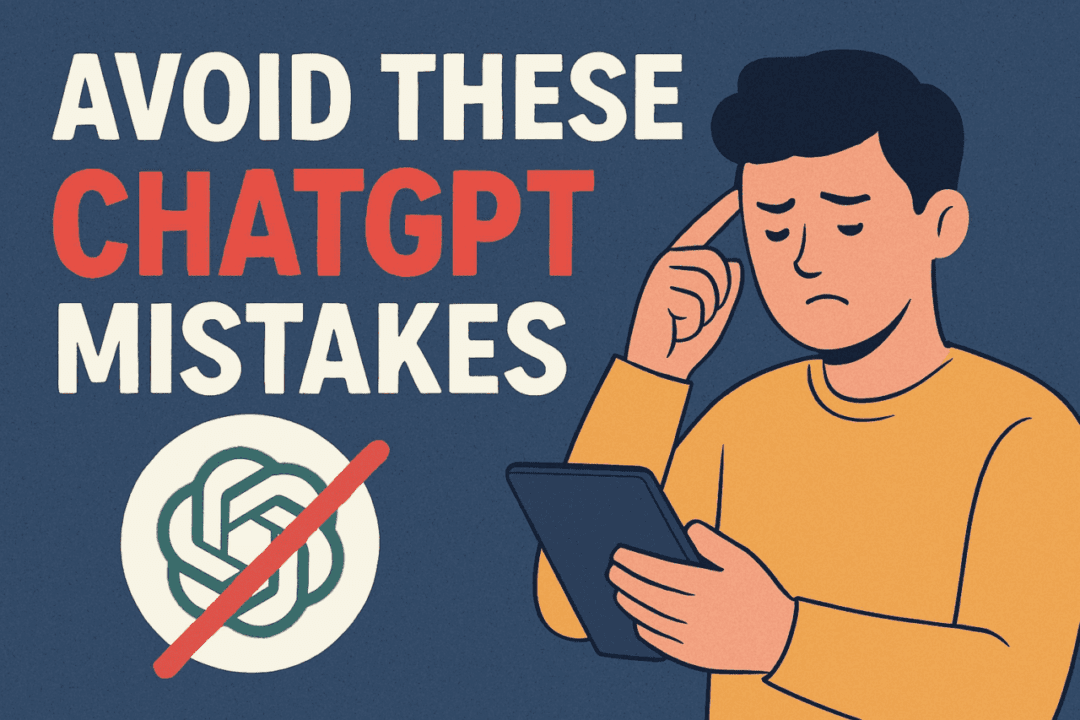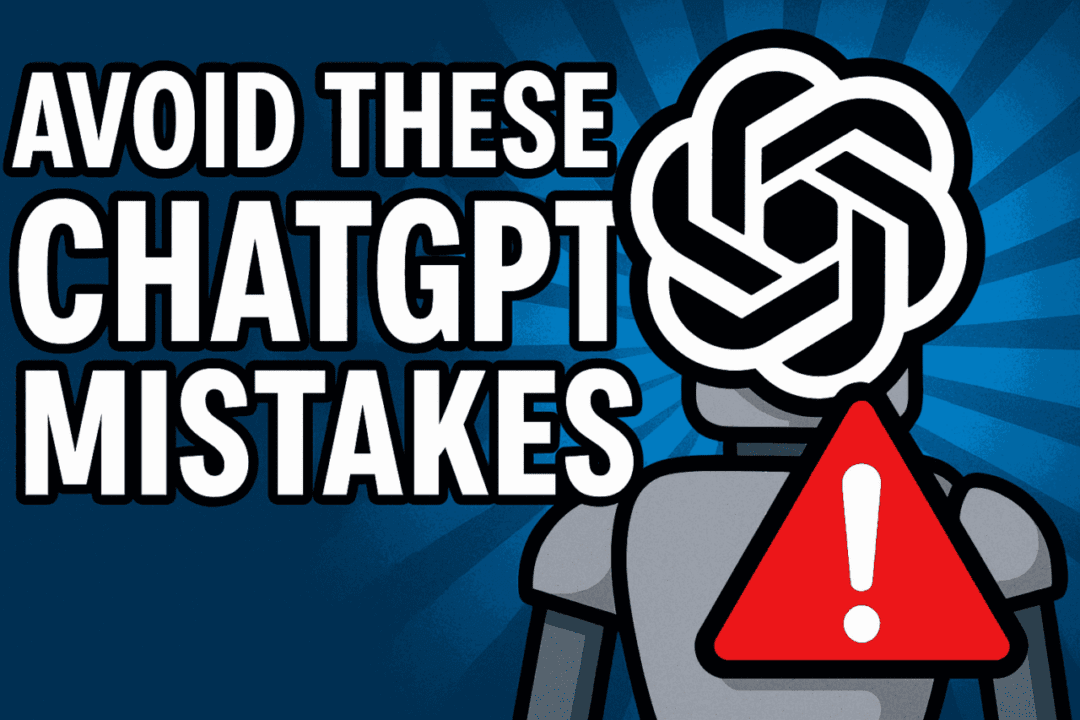ChatGPT has revolutionized how we interact with artificial intelligence, yet millions of users unknowingly sabotage their results through preventable mistakes. Whether you’re a beginner just discovering this powerful tool or an experienced user seeking to optimize your workflow, understanding these common pitfalls can transform your ChatGPT experience from frustrating to phenomenal.

Illustration showing common confusion when using ChatGPT
🚫 The Critical Mistakes That Undermine Your Results
1. Treating ChatGPT Like a Search Engine 🔍
One of the most widespread errors users make is approaching ChatGPT as if it were Google. When you type single-word queries or simple questions without context, you receive surface-level answers that lack depth and personalization.[1][2][3]
The Problem: Search engines retrieve existing information from the web, while ChatGPT generates responses based on patterns in its training data. This fundamental difference means that search-style queries produce generic, often unhelpful outputs.

The Solution: Treat ChatGPT like a knowledgeable colleague or junior team member. Engage in conversational exchanges, provide background information, and build upon previous responses. Think of it as delegation rather than information retrieval—you’re instructing an assistant, not searching a database.[4]
2. Writing Vague, One-Sentence Prompts ✍️
The principle of “garbage in, garbage out” applies perfectly to ChatGPT interactions. Single-sentence prompts without specificity generate equally vague responses.[2][3][5]
Example of a Poor Prompt:
“Write a blog about tax planning.”
Example of an Effective Prompt:
“Act as a certified financial planner writing for small business owners with annual revenues under $500,000. Create a 1,200-word blog post about tax planning strategies for 2025, including specific deductions they often miss, quarterly payment schedules, and retirement account options. Use a conversational tone with practical examples.”
The difference is dramatic. The second prompt provides role definition, target audience, specific requirements, desired length, topics to cover, and tone preferences.[6][7][8]
3. Ignoring the Hallucination Problem 🎭
Perhaps the most dangerous mistake users make is blindly trusting ChatGPT’s confident-sounding responses. The AI regularly experiences “hallucinations”—generating plausible but completely false information with unwavering confidence.[9][10][11]
Real-World Consequences:
- In May 2023, lawyer Stephen Schwartz submitted six fake case precedents generated by ChatGPT to a federal court, resulting in sanctions[12]
- ChatGPT frequently fabricates citations, quotes, and statistics that sound legitimate but don’t exist[13][14]
- GDP figures, historical dates, and biographical information are commonly incorrect[15][13]
The Research Behind It: OpenAI’s own research reveals that hallucinations are mathematically unavoidable in large language models. GPT-5 (o3) still hallucinates 33% of the time on person-related questions and 51% on simple factual queries. Even the improved GPT-4.5 shows a 37.1% hallucination rate in factual tests.[10][11][16][17]
Protection Strategy: Always verify critical information from authoritative sources. Use ChatGPT for ideation, drafting, and brainstorming, but fact-check anything that will influence important decisions.[18][14][9]
4. Accepting the First Response Without Iteration 🔄
Many users treat ChatGPT’s initial output as final, missing opportunities for significant improvement through refinement.[2][3][19]
The Iteration Approach:
- Review the first response critically
- Ask follow-up questions to clarify or expand specific points
- Request different angles: “Can you make this more concise?” or “Add three examples to support this argument”
- Use the simple but powerful prompt: “Are you sure?” to trigger self-correction[2]
The most sophisticated users engage in multi-turn conversations, progressively refining outputs through strategic feedback. This iterative process often produces results ten times better than initial responses.[19][20]
5. Not Providing Adequate Context 📋
Context is the foundation of quality AI responses, yet users frequently omit crucial background information.[2][6][7]
Essential Context Elements:
- Audience: Who will consume this content?
- Purpose: What should this achieve?
- Constraints: Are there word limits, formatting requirements, or exclusions?
- Background: What relevant information does the AI need to know?
- Tone: Should it be formal, casual, technical, or conversational?
Without context, ChatGPT operates in “default mode,” producing bland, generic responses that fail to address your specific needs.[21][22]
6. Failing to Assign a Role or Persona 🎯
When you don’t specify a role, ChatGPT defaults to a neutral, generalist perspective that lacks the depth of specialized expertise.[3][6][5]
Role Assignment Examples:
- “Act as a senior business strategist with 15 years of experience…”
- “Respond as a pediatric nutritionist speaking to concerned parents…”
- “Behave like a skeptical investor evaluating a startup pitch…
Role assignment dramatically improves response quality by establishing contextual boundaries and behavioral expectations.[8][21][19]
7. Overloading Prompts with Multiple Questions ❓
Cramming numerous questions or tasks into a single prompt creates confusion and dilutes response quality.[6][5][21]
Poor Approach:
“What are the key components of a business plan, what funding options are available for startups, how do I protect intellectual property, and what marketing strategies work best for B2B companies?”
Better Approach:
Break this into four separate, focused prompts, each building on previous insights.[5][22]
8. Not Specifying Output Format 📊
When you don’t define how you want information presented, ChatGPT makes arbitrary formatting decisions.[7][20][23]
Format Options to Specify:
- Bullet points vs. numbered lists
- Tables for comparisons
- Paragraphs for detailed explanations
- Step-by-step procedures
- Code blocks with syntax highlighting
- JSON or CSV for structured data
Defining format upfront saves time and eliminates back-and-forth corrections.[24][20][25]
9. Ignoring Custom Instructions ⚙️
ChatGPT offers custom instructions that apply to all your conversations, yet most users never configure them.[24][26][25]
What to Include:
- Your professional role and industry
- Preferred writing style and tone
- Default output formats
- Topics of regular interest
- Communication preferences (formal vs. casual)
Custom instructions eliminate repetitive context-setting in every conversation, dramatically improving efficiency.[26][27]
10. Not Using Advanced Features Appropriately 🔧
ChatGPT offers multiple specialized features that many users either don’t know about or misuse.[28]

ChatGPT cheat map for choosing models, activating features, and crafting effective prompts.
Feature Selection Guide:
- Standard Chat Models (GPT-4o): Quick tasks, creative writing, general questions
- Reasoning Models (o3): Complex problem-solving, technical analysis, critical decisions (expect longer wait times)
- Search Feature: Current events, real-time information, fact-checking
- Deep Research: Comprehensive reports with multiple sources and citations
- Canvas Mode: Document editing, iterative writing projects
- Code Interpreter: Data analysis, calculations, visualization
Choosing the wrong model wastes time and produces suboptimal results.[28]

Common mistakes in AI prompt engineering including vague prompts, unset expectations, skipped feedback, overloaded requests, limited testing, ignoring failures, and expecting immediate perfection.
📊 ChatGPT Performance Comparison: Understanding Accuracy Rates
🎯 The Anatomy of Common Mistakes: A Detailed Breakdown
💡 Best Practices: The DEPTH Method for Superior Results
After testing over 1,000 prompts, researchers have identified a consistent framework that outperforms traditional approaches:[19][20]
D – Define Multiple Perspectives
Instead of a single viewpoint, engage multiple expert personas:
“Assume the roles of three experts: a behavioral psychologist, a direct-response copywriter, and a data analyst. Collaborate to create a marketing email that addresses psychological triggers, compelling copy, and measurable outcomes.”
Set specific, measurable goals:
“Target a 40% open rate and 12% click-through rate. Incorporate three psychological triggers backed by behavioral science.”
Build comprehensive background:
“Context: B2B SaaS product, $200/month subscription, targeting overwhelmed small business founders aged 35-50, previous campaign achieved 20% open rate, main competitor is [Name], unique value proposition is automated workflow integration.”
Divide complex requests into sequential steps:
“Step 1: Identify three core pain points. Step 2: Create a compelling subject line using curiosity gap technique. Step 3: Develop value proposition. Step 4: Include soft call-to-action with urgency element.”
Build in self-evaluation mechanisms:
“After generating your response, rate it on a scale of 1-10 for clarity, persuasiveness, and actionability. For any score below 8, provide a revised version. Mark any uncertain factual claims as [UNCERTAIN] and explain why.”
This structured approach produces consistently superior results across content types.[19][20]
🔐 Critical Reliability Issues: What You Must Know
The Mathematics of Hallucination
OpenAI’s research demonstrates that hallucinations are not bugs but fundamental features of large language models. The error rate for multi-word generation is at least double the error rate for simple yes/no questions, meaning mistakes compound across longer responses.[10][11]
Key Findings:
- Rare facts (mentioned once in training data) have 20% or higher hallucination rates[10]
- Reasoning models (o3, R1) sometimes perform worse than standard models on factual accuracy[16]
- Knowledge cutoff dates mean ChatGPT lacks information about recent events unless using search features[14][29]
Certain applications are inappropriate for AI chatbots:[18][30]
❌ Medical diagnoses or treatment advice
❌ Legal contracts or case law research without verification
❌ Financial investment decisions
❌ Mathematical calculations without checking
❌ Current statistics without search enabled
❌ Personalized health or safety recommendations
For these critical applications, always consult qualified human professionals and use ChatGPT only as a supplementary research tool with rigorous fact-checking.[30][18]
🚀 Advanced Strategies for Power Users
1. Prompt Chaining for Complex Projects
Break large projects into connected sequential prompts, using outputs from one as inputs for the next.[3][23][31]
Example Workflow:
- “Generate 10 blog topic ideas about sustainable living”
- “From the list above, create detailed outlines for the top 3 topics”
- “Using outline #2, write a 1,500-word article with SEO optimization”
- “Create 5 social media posts promoting this article across different platforms”
2. Role-Playing for Skills Development
Use ChatGPT as a practice partner for professional scenarios:[31][32]
- Job interview simulations with tough questions
- Sales call practice with objection handling
- Management scenarios (difficult conversations, performance reviews)
- Public speaking rehearsal with audience questions
Configure the AI to never agree when you’re factually wrong, creating authentic learning experiences.[32]
Develop reusable prompt templates for recurring tasks:[3][23]
Template Structure:
Role: [Specific expert persona]
Task: [Clearly defined objective]
Context: [Relevant background]
Constraints: [Limitations or requirements]
Format: [Desired output structure]
Examples: [Reference materials]
Use thumbs up/down features to improve AI learning, and write brief notes explaining why responses succeeded or failed.[33][34]
🎓 Learning from Failed Outputs
When ChatGPT produces poor results, the mistake is usually in your prompt, not the AI. Common technical failures include:[35][36][37]
Memory System Issues: ChatGPT sometimes “forgets” earlier parts of conversations, especially in very long sessions. Solution: Start new chats for distinct topics.[3][37][38]
Token Limitations: Responses may truncate unexpectedly when hitting context limits. Solution: Request shorter responses or break topics into multiple conversations.[9]
Word Count Failures: ChatGPT notoriously struggles with exact word counts. Solution: Request ranges rather than exact numbers, and manually adjust.[1][35]
Table Accuracy: Complex tables sometimes have missing rows or incorrect data. Solution: Ask for tables in CSV format and verify all entries.[36]
🌟 The Future: Improving Accuracy While Managing Expectations
ChatGPT accuracy has improved significantly—GPT-5 makes 45% fewer factual errors than GPT-4 and 6 times fewer fabricated answers. However, even the latest models still hallucinate regularly, with base rates around 37% for factual claims.[16][17][39]
Realistic Expectations for 2025:
✅ Excellent for brainstorming and ideation
✅ Strong for draft creation and editing
✅ Useful for explaining complex concepts
✅ Helpful for learning and skill practice
✅ Good for code assistance (with review)
⚠️ Requires verification for facts and statistics
⚠️ Not suitable for critical decisions without human oversight
⚠️ Cannot replace professional expertise in specialized fields
⚠️ Limited knowledge of events after training cutoff (without search)
💬 Conclusion: Mastering the Art of AI Collaboration
The most common mistakes people make with ChatGPT stem from misunderstanding its nature—it’s not a search engine, encyclopedia, or omniscient oracle. It’s a sophisticated pattern-matching tool that excels at generating human-like text based on probabilistic predictions.[11][14][29]
Success with ChatGPT requires:
- Specificity in prompts with clear context and expectations
- Skepticism toward all outputs, especially factual claims
- Iteration through multiple refinement cycles
- Strategic feature selection based on task requirements
- Verification of important information from authoritative sources
When used correctly, ChatGPT becomes a powerful amplifier of human creativity and productivity. When used carelessly, it produces confidently wrong information that can damage credibility and create serious problems.[9][18][12]
The key is treating ChatGPT as a collaborative partner rather than an infallible authority—provide it with clear instructions, verify its work, and iterate toward excellence. Master these principles, and you’ll unlock capabilities that seemed impossible just a few years ago 🚀✨[19][20][30]




